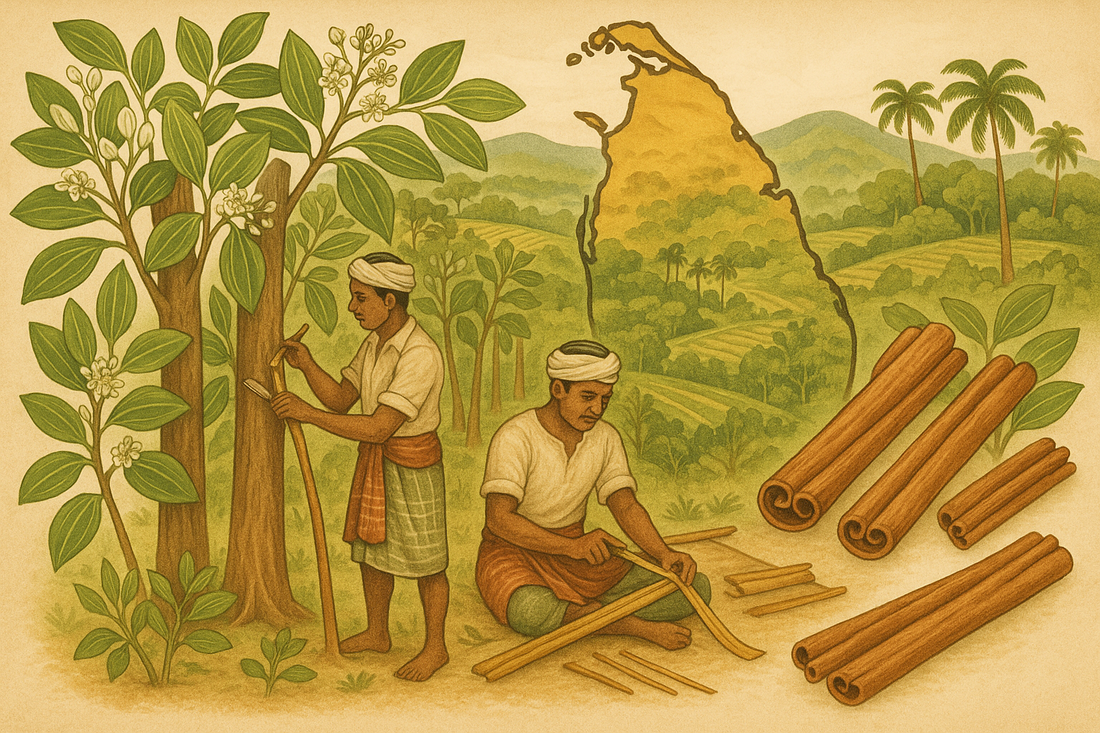
The Story of Ceylon Cinnamon Cultivation in Sri Lanka
Walk into any kitchen, and the warm, sweet aroma of cinnamon is likely to spark memories of baked treats, spiced teas, or festive meals. Yet, few pause to think about where this beloved spice comes from or the remarkable journey it takes before it reaches a jar on the shelf. When it comes to Ceylon cinnamon, often referred to as “true cinnamon,” the story begins on the sunlit coasts and rolling hills of Sri Lanka, the island nation that has cultivated this spice for centuries.
A Land Made for Cinnamon
Sri Lanka’s climate, warm, humid, and kissed by the sea breeze, is perfectly suited for cinnamon. Unlike cassia, the more common cousin grown elsewhere, Ceylon cinnamon requires a delicate balance of soil and weather conditions. Farmers select sandy loams and gently sloping terrain, often planting along contours to protect against erosion and to capture rainwater.
What makes cinnamon unique is that it isn’t harvested from fruit or seeds, but from bark. To encourage this, farmers practice coppicing, cutting the plant down close to the ground so it sprouts multiple slender shoots. These shoots, rather than thick trunks, are where the prized inner bark develops.
From Seed to Field
The journey begins with seeds or young shoots carefully nurtured in nurseries. After a year, when the saplings are sturdy enough, they are transplanted into fields. Rows of cinnamon shrubs are spaced about a meter apart, allowing room for branches to spread while maximizing productivity.
From then on, the farmer’s daily rhythm involves weeding, mulching, and pruning tasks that may sound routine, but each stroke of the hoe or placement of mulch influences the quality of the future harvest. Cinnamon, after all, is a crop of patience. It takes nearly three years before the first stems are ready to be cut.
The Moment of Harvest
Timing is everything. A skilled farmer waits until the stems are about three to five centimeters thick and the bark deepens in color. Harvesting often begins in the early morning, when the stems hold the right level of moisture. The cut stems are carried carefully to the peeling sheds, where another layer of tradition and craftsmanship takes over.
The Art of Peeling Cinnamon
Peeling cinnamon is a craft that has been handed down through generations in Sri Lanka. Each stem undergoes a delicate transformation:
- The rough outer bark is scraped away.
- The stem is gently tapped to loosen the inner bark.
- With practiced hands, thin sheets of inner bark are coaxed free, curling naturally as they separate.
These curls are known as quills, and they are the hallmark of Ceylon cinnamon. To create long, uniform quills, peelers skillfully roll and pack smaller strips inside larger ones until they form perfect rods. These are then dried in the shade, bundled, and tied, ready to journey into kitchens across the world.
What Makes Ceylon Cinnamon Special
One of the reasons Ceylon cinnamon is so prized is its gentle flavor profile, sweet, citrusy, and refined, unlike the harsher, spicier cassia. But beyond taste, Ceylon cinnamon contains very low levels of coumarin, a natural compound that can be harmful in large doses. This makes it a healthier choice for those who use cinnamon regularly in cooking or herbal remedies.
In Sri Lanka, cinnamon is not just an export commodity; it’s woven into everyday life. From the spice markets of Colombo to the small family plots in Galle or Matara, it represents both livelihood and legacy.
A Heritage of Skill Sustainability
Cinnamon cultivation in Sri Lanka is not simply about farming; it is about heritage and sustainability. Coppicing means the plant is never destroyed; new shoots replace the harvested ones, ensuring longevity. The knowledge of peeling, passed from parent to child, safeguards both the quality of the spice and the dignity of the profession.
The cinnamon industry also provides livelihoods to thousands of families, from farmers and peelers to traders and exporters. Supporting authentic Ceylon cinnamon means sustaining these communities and preserving a craft that cannot be replicated by machines.
The next time you stir cinnamon into your tea or sprinkle it on a dessert, imagine the journey it has taken from a sunlit cinnamon bush in Sri Lanka, through the hands of a skilled peeler, to the fragrant quills carefully dried and bundled.
Ceylon cinnamon is more than a spice. It is a story of land and climate, patience and skill, tradition and trade. It embodies the rhythm of rural Sri Lanka, where every quill represents not just flavor, but heritage.
If this story has whetted your appetite for true cinnamon, why not taste it for yourself? Explore our organic spics shop and bring home the warmth, sweetness, and authenticity of Ceylon cinnamon straight from Sri Lanka’s cinnamon heartland.
For a deeper dive into the history and cultivation of cinnamon, you can also explore the Food and Agriculture Organization to learn about Ceylon cinnamon.
